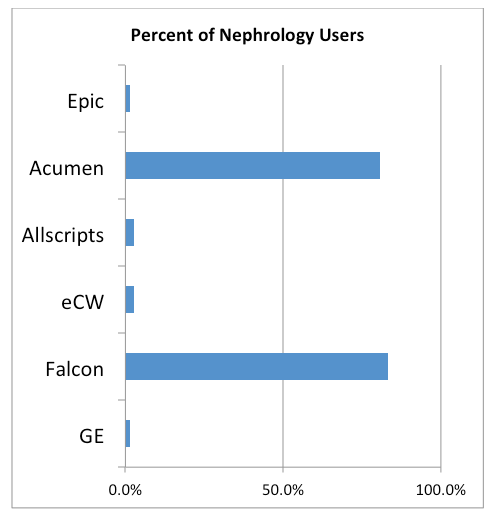Nephrologists love numbers. Not to be stereotypical, but to truly understand, appreciate and, yes, enjoy complex electrolyte problems, acid-base disorders and the intricacies of some of the more esoteric Kt/V formulas, you cannot hide from calculations. This left-brained ability also comes in handy if you spend some time out on data.gov, which is where I recently found the opportunity to crunch a few numbers.
Setting up the equation
Before we dive in, it is important to note the meaningful use program has reached a tipping point. Secretary Sebelius recently announced more than 80% of hospitals and 50% of eligible professionals have received a meaningful use incentive for successfully attesting for meaningful use. Counted among the eligible professionals are just over 3,800 nephrologists who have received almost 4,800 payments for participating.
Calculating the vendors
Today’s number crunching exercise involves the simple task of determining what EHR these nephrologists have used. If you examine the breakdown by payment and only consider the complete EHRs (which represent the vast majority of attestations by nephrologists) through the end of April of this year, you get something that looks like the pie chart below.
Observing the outcome
One does not need to go to deep into the vendor market to account for the majority of nephrologists who are attesting for meaningful use. This distribution has changed very little since I first took a look about a year ago. Somewhat hidden from view is the remarkable fragmentation of this market. The category marked “other” in the chart above consists of almost 100 unique electronic health record companies. Stated another way, almost 1,200 of our colleagues are using EHRs that, in many cases, have only a handful of nephrologists as customers.
This begs the question: Among all eligible professionals using a specific EHR and receiving a meaningful use incentive, what percentage are nephrologists? The answer to that question for the six vendors in the pie chart is displayed in the bar chart below.
Not to pick on any EHR vendor in particular, let’s take a look at Epic. Epic has the largest number of nephrologists attesting for meaningful use; of course, Epic also has the largest number of total providers attesting. Through the end of April almost 55,000 MU payments were received by providers using Epic, nephrologists made up 1.5% of that group, a figure that is very close to the relative distribution of nephrologists among all providers across the country.
Predicting the future
Beyond the fun with numbers piece, what are we to make of this exercise? As always it’s tough to predict the future, but I suspect we will see a couple of things.
First, consolidation in the market is almost certainly on its way. We are beginning to see some of that today as EHR vendors are acquired and others are electing not to pursue the second stage of meaningful use. (Excuse me, I meant to say “2014 Edition Certification,” as ONC prefers to call it.) Coupled with the excitement surrounding the looming transition from ICD-9 to ICD-10, the certification requirements create an environment that is not for the weak of heart.
In addition, I think we will see increasing migration to specialty-specific EHRs. Internally we are witnessing that today; as legacy contracts reach their expiration dates, an increasing number of EHR conversions are taking place. Finally, swirling around in the mix is the very real possibility that many nephrologists will file for a hardship exception related to their dialysis encounters, effectively opting out of the meaningful use program. If that occurs, exercises like this one will become a bit more challenging—music to the ears of a numbers lover.





Leave a Reply